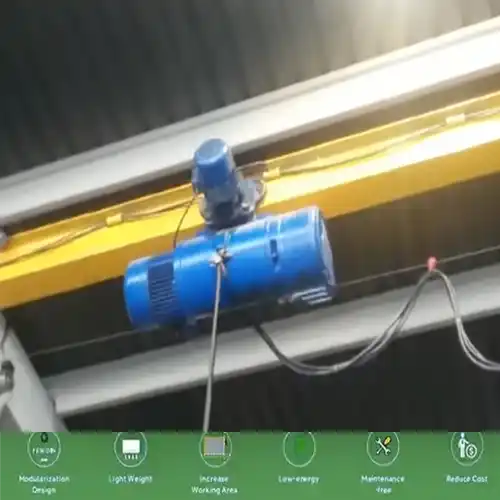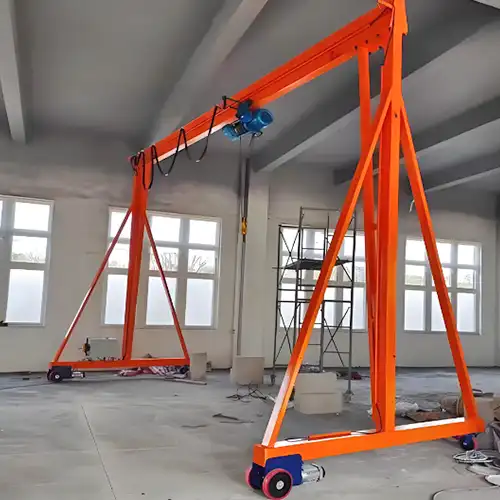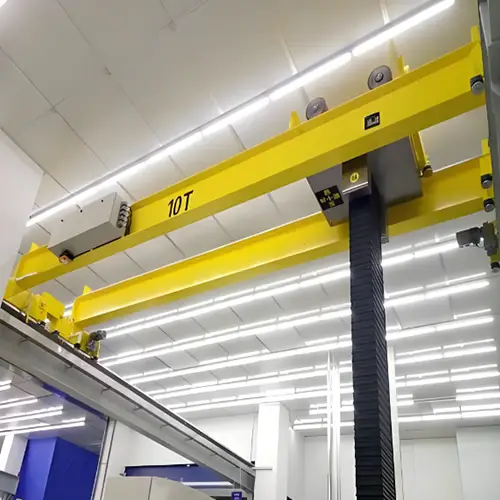Overhead Crane for Maintenance in Water & Wastewater Pump Room
2 ton to 10 ton overhead cranes for water & wastewater pump rooms. Cost-effective, space-saving bridge crane solutions for safe, reliable pump maintenance.
Category: Maintenance Crane
Your Trusted Overhead Crane Manufacturer & Supplier
2 Ton to 10 Tons Overhead Cranes for Pump Maintenance
Overhead Cranes for Water and Wastewater Pump Rooms for Installation & Maintenance
2 ton to 10 ton overhead cranes for water & wastewater pump rooms. Cost-effective, space-saving bridge crane solutions for safe, reliable pump maintenance.
Overhead Cranes in Water and Wastewater Pump Rooms
Water and wastewater pump rooms may not look like heavy industrial sites, but they still require reliable lifting solutions. Pumps, motors, valves, and other components are heavy enough that manual handling is neither safe nor efficient. This is where overhead cranes in the 2–10 ton range come into play. They give maintenance teams a practical way to lift, replace, or service critical equipment without having to rely on external contractors or improvised lifting setups.
- Pumps and motors in pump rooms often weigh anywhere from a few hundred kilograms to several tons.
- An overhead crane ensures these loads can be lifted safely and positioned with accuracy.
- The compact size of these cranes makes them a good fit for the confined layouts typical of pump rooms.
Why Light-Duty Cranes Matter in Confined Spaces
Unlike large power plants or steel mills, water and wastewater facilities usually deal with medium-weight machinery and limited floor space. Installing a massive double girder crane isn't practical, but a single girder or monorail system is just right. These cranes can be fitted into existing buildings with minimal structural changes and still handle routine lifting tasks with ease.
- Single girder cranes: suited for moving equipment across the whole pump room.
- Monorail cranes: ideal for point-to-point lifting along a set path, such as lifting pumps directly out of wells.
The smaller tonnage keeps the cost down while still covering the actual lifting needs.
Who This Information Helps
This content is aimed at the people who are directly responsible for keeping pump rooms operational. They're not looking for luxury features—they need a crane that gets the job done reliably and within budget.
- Facility managers: looking to improve uptime and reduce external maintenance costs.
- Engineers: focusing on safe installation within existing structural limitations.
- Procurement teams: evaluating crane options that balance price, durability, and ease of service.
Typical Crane Types for Pump Rooms
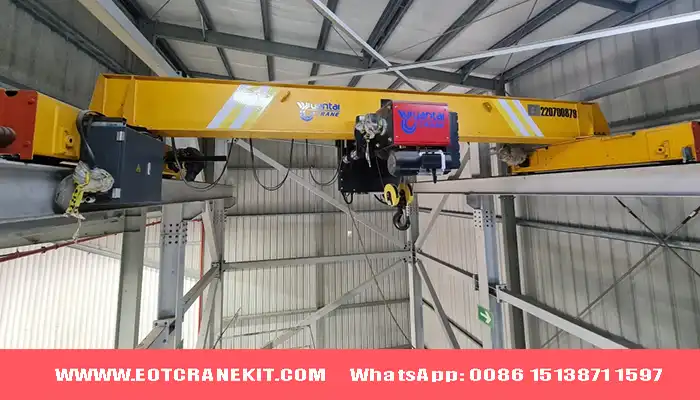
For most pump room applications, a single girder overhead crane is the go-to choice. It's designed to cover the entire working area of the pump room, allowing maintenance staff to move pumps, motors, and valves with ease. These cranes typically handle loads between 2 and 10 tons, which matches the weight range of common equipment in water and wastewater facilities.
- Cost-effective solution: usually more affordable than double girder designs, yet still durable for routine lifting.
- Compact build: requires less headroom, making it suitable for low-ceiling pump rooms.
- Simpler installation: lighter structure means reduced demands on the building's support beams.
This type of crane works best when equipment needs to be moved across different positions in the pump room rather than just lifted straight up and down.
When pump rooms are long, narrow, or built around a specific process layout, a monorail crane system often makes more sense. Instead of covering a whole room, the crane runs along a fixed path—perfect for lifting pumps directly out of wells or handling motors along a single service line.
- Space-efficient: fits into tight areas where a bridge crane wouldn't be practical.
- Minimal structural impact: runs on a single beam, which can be mounted on existing supports.
- Repetitive lifting tasks: ideal if maintenance often involves lifting in the same spots over and over.
Monorails are especially helpful in older facilities where there's no room for a runway system but reliable lifting is still required.
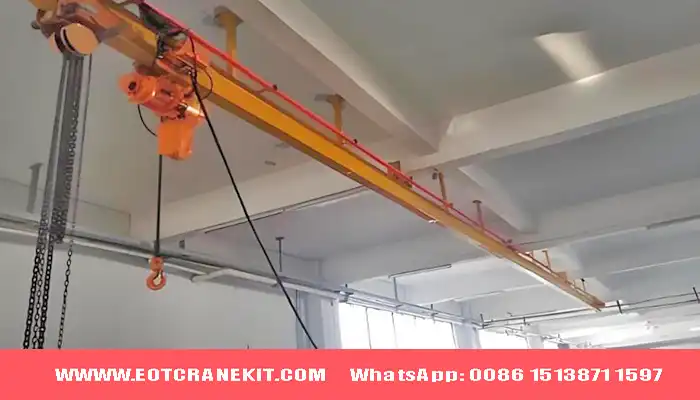
Optional Features for Customized Pump Room Cranes
Both single girder and monorail cranes can be customized to make them better suited for the demanding, often damp environments of water and wastewater treatment. Adding the right features upfront improves performance and extends service life.
- Corrosion-resistant finishes: galvanized or epoxy-coated surfaces to withstand moisture and chemical exposure.
- Stainless steel lifting chains or hooks: prevents rusting in humid pump rooms.
- Explosion-proof hoists: recommended for facilities where chemical vapors or flammable gases may be present.
- Low headroom designs: allows cranes to operate efficiently even when ceiling space is limited.
- Remote control operation: gives operators safe distance and better visibility during lifting.
- Adjustable speed control: smoother handling of delicate pumps and motors, reducing the risk of damage.
Capacity/Tonnage Considerations
Selecting the right crane capacity is not about guessing—it's about matching the lifting equipment to the actual needs of the pump room. In most water and wastewater facilities, the 2–10 ton range is more than enough. This capacity comfortably covers the weight of pumps, motors, and other machinery typically found in these environments.
- Pump weight and accessories: Many centrifugal and submersible pumps weigh between 1–5 tons, but when you add motors, housings, or piping sections, the total lift can reach 7–8 tons.
- Maintenance equipment: Hoists are also used for lifting spare parts, valve assemblies, or even small portable generators. These don't always weigh much individually, but a margin is needed for combined loads.
- Safety margin: A good practice is to allow 20–30% extra capacity beyond the heaviest expected load. For example, if the heaviest pump is 6 tons, a 10-ton crane ensures safe and stress-free operation.
By planning capacity around both everyday lifting and occasional heavier loads, pump room operators avoid overloading risks while keeping the crane system efficient and cost-friendly.
Benifits
A 2–10 ton overhead crane isn't overkill—it's exactly what a pump room needs. These cranes deliver practical lifting power while keeping installation simple and budgets under control.
- Light-duty, cost-effective solutions: Instead of investing in large-scale cranes designed for heavy industry, facilities can focus on compact systems that do the job without overspending.
- Minimal disruption to existing infrastructure: Small cranes require less reinforcement, making them easier to install in existing buildings without major modifications.
- Safe and reliable lifting: From pulling pumps out of deep wells to swapping motors during maintenance shutdowns, overhead cranes provide controlled handling that reduces downtime and protects equipment.
In short, a properly sized 2–10 ton crane balances cost, safety, and practicality. It's a solution designed to fit the realities of pump room operations—not a one-size-fits-all system.
Installation and Space Considerations
Fitting a crane into a pump room isn't just about capacity—it's also about whether the building can support it. Water and wastewater facilities often have tight layouts, low ceilings, and limited space to add new equipment. A well-planned installation makes sure the crane works smoothly without disrupting day-to-day operations.
- Headroom and structural support: Many pump rooms have low ceilings, so it's important to measure available headroom before deciding between a single girder crane or a monorail. Structural beams also need to be checked for load-bearing strength before installation.
- Runway beam placement: For single girder cranes, runways must be properly aligned along the pump room walls or supports. In the case of monorail cranes, the beam should follow the lifting path, whether that's over pump wells, along a maintenance corridor, or above motor bays.
- Accessibility for maintenance: Cranes should be installed so that operators can access pumps, valves, and motors easily. If the crane can't reach critical equipment, maintenance teams may still need outside lifting equipment—which defeats the purpose.
Taking the time to plan installation around room layout and maintenance routines helps ensure that the crane delivers long-term value instead of becoming an underused piece of equipment.
Safety and Compliance
Pump rooms may be smaller than steel plants, but they still require cranes to meet strict safety standards. A well-installed overhead crane reduces risks for staff and ensures compliance with local and international safety codes.
- Safety standards: Overhead cranes used in water and wastewater facilities typically follow standards such as ISO, CE, and local occupational safety regulations. Choosing a supplier with third-party certification adds peace of mind.
- Load testing and inspection: Every new crane should be tested under load before being put into service. Regular inspections—monthly, quarterly, and annually—help spot wear on hoists, hooks, and electrical systems before they become hazards.
- Operator training: Even though these are light-duty cranes, operators still need proper training. Knowing safe lifting limits, how to use remote controls, and what to do during an emergency stop is essential in a pump room where space is tight.
Case Studies
5-Ton Single Girder Crane in a Municipal Pump Station
A city-owned wastewater treatment plant needed a safe way to lift and replace large pumps during routine shutdowns. They chose a 5-ton single girder overhead crane installed above the main pump bay. The crane allowed operators to lift entire pump assemblies directly out of the sump, rotate them, and move them onto a service platform.
- Reduced the need for mobile cranes, which previously had to be hired for every major maintenance task.
- Improved uptime by cutting pump replacement time from days to hours.
- Enabled in-house maintenance crews to handle more work safely.
3 Ton Monorail Crane for Chemical Dosing Pump Maintenance
In a chemical dosing building, space was very tight. The client installed a 3-ton monorail crane running directly over the pump line. This allowed operators to lift dosing pumps straight up, slide them along the beam, and set them down at a maintenance bench.
- Simple design that fit the narrow layout without major structural changes.
- Made repetitive maintenance tasks much safer, especially in a corrosive environment.
- Prevented downtime by allowing fast removal and replacement of pumps.
Key results across both cases:
- Improved maintenance efficiency.
- Reduced downtime and reliance on outside lifting contractors.
- Minimal disruption to existing facility layout.
Maintenance and Long-Term Support
An overhead crane is not a "set it and forget it" investment. Pump room environments are often humid, and in some cases, chemical vapors can speed up wear on parts. Keeping cranes in good condition means planning for maintenance and long-term service right from the start.
- Routine inspections: Scheduled checks should focus on hoists, wire ropes or chains, electrical systems, and corrosion-prone parts. Special attention is needed for cranes operating in damp or chemical-rich environments.
- Spare parts and service contracts: Having a supplier that provides spare parts quickly—and offers service contracts—helps avoid long downtimes. A failed hoist in a pump room can halt critical water supply or treatment operations.
- Future capacity upgrades: Facilities expand over time. Choosing a crane system that can be upgraded with a higher-capacity hoist or extended runway beams makes the investment last longer.
With proper support and planning, a 2–10 ton overhead crane can reliably serve a pump room for decades, keeping operations safe and efficient.
Conclusion
Selecting the right overhead crane for a pump room isn't about choosing the biggest or most advanced system—it's about choosing one that actually fits the space and the workload. In water and wastewater facilities, a 2–10 ton single girder or monorail crane is often the perfect match. It provides enough lifting power for pumps, motors, and valves without demanding costly building modifications.
The benefits are clear:
- Cost-effectiveness – light-duty cranes deliver reliable performance without the expense of heavy industrial systems.
- Space efficiency – compact designs fit into low headroom or narrow pump room layouts.
- Safety and reliability – routine maintenance, pump removal, and equipment replacement can be carried out with less risk and downtime.
To get the best solution, facility managers and engineers should share detailed pump room information with suppliers—room dimensions, ceiling height, equipment weights, and environmental conditions. The more accurate the details, the better the crane recommendation will be.
In the end, a well-chosen pump room crane isn't just another piece of equipment—it's a tool that keeps water and wastewater systems running smoothly, safely, and cost-effectively for years to come.
Related Products
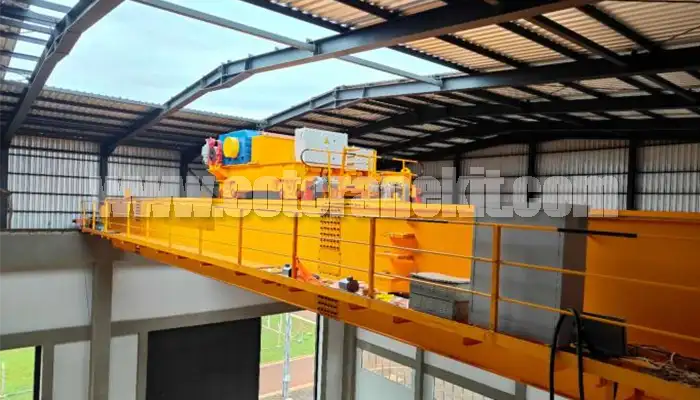
Latest project
150 Ton Overhead Crane Installation Feedback – Paraguay Case
QDX 150 ton overhead crane in action in Paraguay. Installation photos, video, and client feedback show performance, safety, and heavy-lifting efficiency.
Free consultation to Confirm Parameters & Specifications and Get
Latest Crane Price & Crane Rate.
- Types of overhead cranes : _______?
- Optional: Overhead travelling crane, goliath gantry crane,Slewing jib crane, Single girder or double girder crane,small portable crane or kbk crane, etc.
- Capacity of overhead crane: _______?
- Optional: 0.25ton, 0.5 ton, 1 ton, 2 ton, 3ton, 5 ton, 10 ton,15ton, 20ton, 25 ton, 30ton,35ton, up to 550ton, etc.
- Crane span & lifting height : _______?
- Crane travelling length : _____?
- Control of overhead crane:_______?
- Optional: pendant/ remote/cabin control
- Voltage supply of overhead crane:_____?
- Eg,: 380V50/60HZ,3Phase or others,etc.
- Application/usage of crane:_______?
- Eg,: Steel mill, ,injection mold, cement,stone, concrete,granite, general manufacturing, etc.
Just leave a message via the contact form and our hoist and crane engineer will contact you with in 24working hours.
Get In Touch
